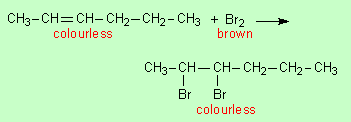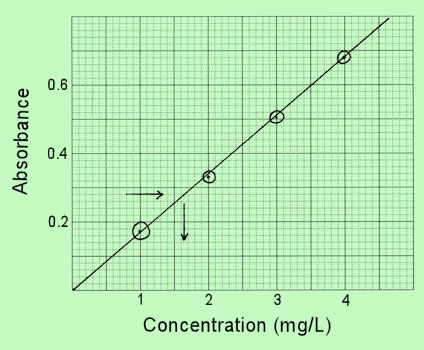| Question 16 (5 marks) | |||||||||||
| Factual
material you need to know. In describing the test be sure to use liquid compounds; remember that the simplest alkanes and alkenes (up to butane and butene) are gases at room temperature. This is a simple test so make sure you describe fully what you did and what you observed. The equation given here is a simplified one that seems to be acceptable to the HSC examiners. The more correct equations are given on p 10 (though using 3-hexene instead of 2-hexene) (p 9-10) |
(a) |
|
|||||||||
| (b) | Alkenes decolorise
brown bromine water whereas alkanes do not. In our experiment drops of
brown bromine water were added to 1 mL samples of the liquid compounds to
be tested, hexane and 2-hexene, with the test tubes being gently shaken
between additions. The 2-hexene, an alkene, decolorised the bromine water
while the hexane, an alkane, did not. |
||||||||||
| Question 17 (5 marks) | |||||||||||
| You
need to analyse this question carefully before starting to write. The normal treatment for municipal water supplies in Australia is clarification by flocculation and filtration followed by sterilisation by chlorination. Sterilisation is definitely to make the water safer to drink, but is clarification really to make the water safer to drink or is it more to make the water more appealing to look at and possibly to improve its taste? For this question if it is clarification you want to talk about you need to give it a safety slant. The process of flocculation can remove small amounts of harmful heavy metals if they are present and to some extent it can reduce the concentrations of viruses and parasites. So what features of catchments are these processes of clarification and sterilisation protecting people from? Farming activities particularly those involving sheep, cattle, pigs and poultry can lead to harmful bacteria, viruses and parasites getting into the water as rain washes across animal droppings (faeces). Forestry activities can lead to land clearing so that runoff from the area picks up considerable quantities of suspended solids that cause the water in the dam to become turbid. Roads through the catchment can have similar effects. Mining activities can also result in increasing sediment loads and to heavy metals getting into the water; mining can also alter pH necessitating pH adjustment in the water treatment plant. You could use any of these as your two features provided you geared your treatment processes to them. Of course the primary method of making water safe to drink is to keep virtually all human activity out of the catchment area, but that is probably not part of the question.. (p 289-91, 262-77) |
The
features of the catchment determine what undesirable substances get washed
into the storage dam and so what treatment is needed to make the water
safe to drink. Two features are: (1) current (or previous) logging activities that have left parts of the catchment cleared of its original tree and scrub cover so that rain runoff washes considerable quantities of sediment into the dam, some of which stays in the water as suspended solids (very fine particles) and makes the water turbid. In such cases the water needs to be clarified by flocculation and filtration. In this process Fe3+ or Al3+ is added to the water, pH adjusted and the water gently stirred so that a precipitate of Fe(OH)3 or Al(OH)3 forms. As this precipitate coagulates into larger particles the fine suspended particles originally in the water adsorb onto it. The precipitate is removed with a coarse sand filter to produce very clear water. This process is intended primarily to improve the appearance of the water, to prevent annoying depositions in pipes and fittings and to remove any unpleasant taste the raw water had. However it can make the water safer to drink in that if the raw water had been contaminated with heavy metals this process would have precipitated much of them out as well, and it would also have removed (by adsorption) significant amounts of any viruses and parasites present. (2) pastoral activities within the catchment such as grazing cattle or sheep. This results in the runoff water picking up bacteria, viruses and parasites as it passes over animal faeces and flows into the dam. Such microorganisms are harmful to people and so to make the water safe to drink they are removed by sterilising the water, generally with chlorine (though use of the more effective but more expensive ozone is gaining in popularity). This sterilisation is generally the last step in water treatment.
|
||||||||||


